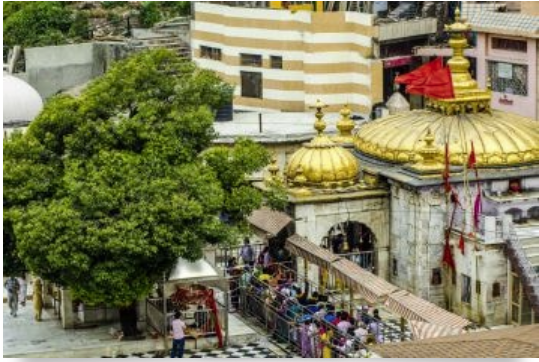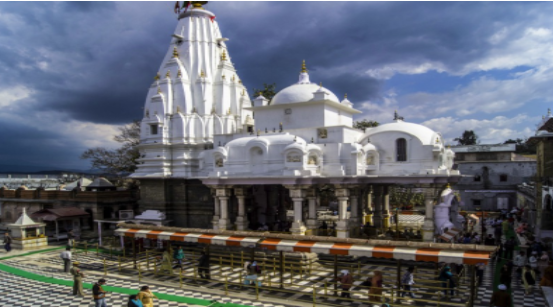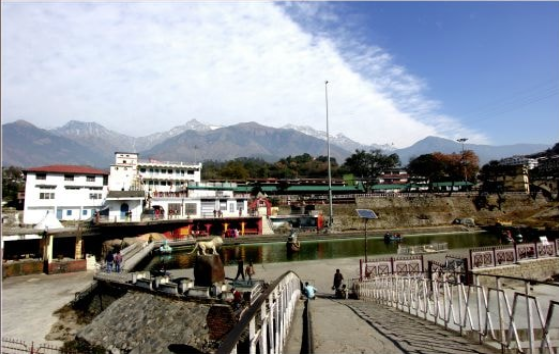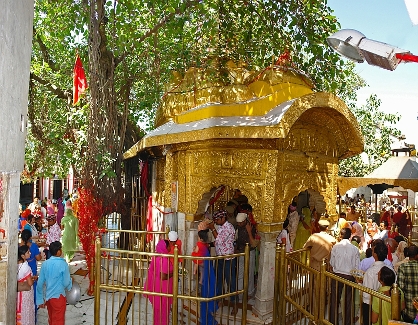The Shakti Peeths (Seat of Shakti) are places of worship dedicated to Shakti or Sati, Lord Shiva’s wife.
Origin Of Shakti Peeths:
The legend has it that Great King Daksha Prajapati’s youngest daughter Sati married Lord Shiva. Even though he reluctantly agreed to the union, he despised Shiva for failing to give appropriate respect to him at a Yagna and his uncivilized lifestyle.
Daksha orchestrated a big Yagna and purposely evaded Shiva and Sati. Sati wanting to attend the Yagna against the wishes of her husband who discouraged her to not go to a function where they are not welcomed. Sati went alone to the Yagna. In the ceremony she was insulted and unable to bear humiliation of her husband she immolated herself into the sacrificial fire.
Enraged Shiva created Virbhadra from his jatha (lock of hair) to kill Daksh. Distraught Shiva carried Sati’s lifeless body around the earth. The earth started trembling with his Rudra Tandav. Lord Vishnu to restore peace on earth used his Sudarshan Chakra on the body cutting it into 51 pieces. Different parts of Sati’s body were said to have fallen on earth and since then they have become Shakti Peeths.
There are 5 Shakti Peeths in Himachal Pradesh.

1) Naina Devi Temple
The peeth is located on a hilltop in Bilaspur District. In this temple Sati’s eyes had fallen. She is worshipped as a Pindi with 2 gold eyes.
The spiritual destination is well connected, located 85 km from Bilaspur, 100 km from Chandigarh and 30 km from Anandpur Sahib Railway station.
Raja Bir Chand of the princely state of Bilaspur built this temple. The story has it that a Gujjar boy named Naina informed the king about his cow providing milk to a piece of stone and the dream of stone being a Pindi. Idol of Goddess Durga was discovered on removing the stone slab.
All year round, the temple attracts enormous crowd from the neighbouring states especially during Navratris. An idyllic site overlooking the Gobind Sagar Lake is an added advantage of visiting the remarkable Naina Devi Temple.
The government took over the management of the popular shrine on December 17, 1985 under Himachal Pradesh Public Religious Institutions and Charitable Endowment Act, 1984.
2) Chintapurni Temple
Head of Sati fell in Bharwai in Una district. The goddess is worshipped as Maa Chinnamastika Devi, one of many manifestations of Maa Durga.
The temple connected with roads is 53 km from Una and 20 km away from the Railway Station. It is best-visited off-season from November to March to avoid rush and crowd.
The tale has it that temple was built after the Goddess presented herself to Pandit Mai Dass, a devoted worshipper. His lineage still serves the temple.
The shrine attracts devotees from Punjab, Haryana and Himachal Pradesh. The famous Chintapurni Mela is celebrated thrice in a year from March to October.
The captivating experience on high altitude relieves the devotee from any stress (chinta) and gets rid of all the troubles. The management of the temple was taken over by the government on June 12, 1987.

3) Jawalamukhi Temple
This peeth is located in Jawalaji town in Kangra district. The tongue of Sati is said to have fallen on this land. There is no idol in this temple. The goddess appears as blue flames through the crevices in the rocks.
The temple is easily accessible by flights, railways and well-connected roads. The Gaggal airport is 46 km from Jawalaji, 20 km from Jawalji Railway station and 56 km from Dharamshala.
The folklore has it that Goddess revealed herself to the King of Kangra, Raja Bhumi Chand Katoch in his dreams who then set out to find the temple.
In 1815, Maharaja Ranjit Singh gold plated the dome of the temple.Gorakh Dibbi and Teda mandir are another destinations for the pilgrims.
The divine experience of eternal flames, rich history and the pristine beauty of mountains is sure to leave the pilgrims and the travellers spell bounded. The government acquired the temple’s management on March 7, 1987.

4) Brajeshwari Temple
Maa Sati resides here in the form of Goddess Brajeshwari. In this temple goddess’s left breast had fallen. The peeth is located in the town of Nagarkot in Kangra district. It is easily accessible by roads, flights and railways.
It is located 18 km from Dharamshala, 7 km from Kangra airport and 5 km from Kangra Railway station. The temple is best visited from February to November when the climate is ideal.
The temple is at the end of the busy Jansali Bazar. The magnificent valley of Kangra covered by lush greenery, snow covered trails of Dhauladhar and unending streams is heaven for the pilgrims and tourists.
According to Hindu mythology, the Pandavas built the original temple after Maa Durga came into their dreams to construct the temple. Despite being plundered numerous times by Muslim invaders and devastating earthquake in 1905, the temple still stands strong with its divine presence. The government took over the management of the shrine on April 11, 1986.

5) Chamunda Temple
Another famous temple in Kangra district is located 15 km from Dharamshala. The temple lies on the bank of Baner River.
It is considered as an abode of Shiva and Sati. The name Chamunda is derived from the names of two demons Chanda and Munda whom she killed.
Chamunda, a tribal goddess is a fierce form of Maa Durga and one of the seven Matrikas to protect the good from evil. She is worshipped in form of an idol with red cloth around accompanied by the idols of Lord Bhairav and Lord Hanuman as guards.
Ancient tales have it that the temple was created 400 years ago. In a dream to a Brahmin priest, the Devi gave her consent to move the temple. But the men were unable to lift the idol. The priest prayed again only to know that the idol to be treated as no ordinary stone. She instructed him to take a bath before dawn and wear new clothes. She told him to worship the idol sincerely. After doing this, he will be able to raise the idol easily. The priest followed the instructions enabling him to establish the temple.
This temple has a lot of significance among the locals. It also features a lake that is considered as an embodiment of purity. The architecture of the temple is inspired by the tradition of Tantra, which resembles the rising peaks of Dhauladhar range. The rich heritage of the temple captivates one to no bounds. The management of the temple was taken over by the government on March 3, 1994.
Holding a master’s degree in Economics from Punjab University, Aditi Sharma is pursuing a masters course in Journalism from Amity University, Noida. A Yoga practitioner with a flair for calligraphy and organic gardening, Aditi has been decorated with a silver medal for her volunteer work with Global Cancer Concern India.




